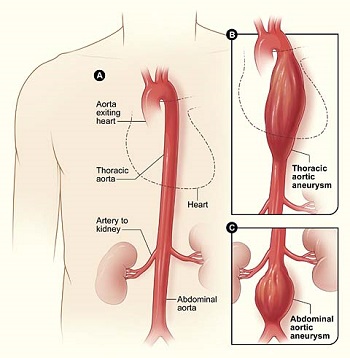Aortic Aneurysm and Aortic Dissection
An aortic aneurysm is a balloon-like bulge, caused by weakness or degeneration in the wall of the aorta, the body’s primary and largest artery that runs from the heart, through the chest and into the abdomen.
Aortic Aneurysm Symptoms and Diagnosis
Left untreated, an aortic aneurysm can continue to grow until it ruptures. A ruptured aortic aneurysm is a potentially life-threatening situation that can occur without warning. Watch our video that explains why it's essential to seek treatment if necessary.
Abdominal Aortic Aneurysm (AAA)
 Most aortic aneurysms occur in the abdominal part of the aorta. AAAs usually develop slowly and often don't cause symptoms until they have grown large enough to press on nearby body parts and block blood flow. At that point, symptoms may include:
Most aortic aneurysms occur in the abdominal part of the aorta. AAAs usually develop slowly and often don't cause symptoms until they have grown large enough to press on nearby body parts and block blood flow. At that point, symptoms may include:
- A throbbing feeling in the abdomen
- Deep pain in the back or the side
- Steady, gnawing abdominal pain
If an AAA ruptures, symptoms may include:
- Sudden, severe pain in the lower abdomen and back
- Nausea and feeling sick to your stomach
- Vomiting
- Constipation and problems with urination
- Clammy, sweaty skin
- Feeling light-headed
- A rapid heart rate upon standing up
Thoracic Aortic Aneurysm (TAA) & Aortic Dissection
Thoracic aortic aneurysms occur in the chest portion of the aorta and may not cause symptoms until it grows exceptionally large, ruptures or dissects. In these cases, symptoms may include:
- Pain in the jaw, neck, back or chest
- Coughing and hoarseness
- Shortness of breath
- Trouble breathing or swallowing
If a TAA ruptures or dissects, sudden, severe, sharp or stabbing pain that starts in the upper back and moves into the abdomen may be felt. Pain may also be felt in the chest and arms.
An aortic dissection is a life-threatening condition that develops when there is a split in one or more layers of the aortic artery wall, which can be caused by a ruptured aneurysm. The split or tear enables blood to seep between the aortic wall’s three layers, which can eventually lead to aortic rupture and catastrophic bleeding. There are two types of aortic dissection:
- Type A dissection , which is more dangerous, develops at the point where the aorta exits the heart. The tear may extend to the descending portion of the aorta.
- Type B dissection develops in the lower portion of the descending aorta and may extend into the abdomen.
Internal bleeding from a ruptured AAA or TAA is a life-threatening condition in which blood pressure drops so low that the brain, kidneys and other vital organs can't get enough blood to work well. If you have any symptoms of ruptured AAA or TAA, or aortic dissection, call 911.
Aortic Aneurysm Risk Factors
- Male gender
- Over age 65
- History of smoking
- Family history of aortic aneurysm or dissection
- History of high blood pressure and atherosclerosis, which can weaken aortic walls
- Trauma, such as a car accident, which can injure the aorta
Although aortic aneurysm may not be preventable, early diagnosis and treatment can help prevent rupture and dissection. You may benefit from early, routine screening if you are at risk for developing aneurysms.
Your doctor may recommend routine screening if you are:
- a man between age 65 and 75 who has ever smoked
- a man or woman between age 65 and 75 with a family history of aneurysms
Often, an aortic aneurysm that hasn’t caused symptoms may be found by chance during a routine physical exam, or through an imaging test that is performed for another reason. A rapidly growing aneurysm that is about to rupture can be tender and very painful when pressed. A doctor may also hear rushing blood flow when listening to your abdomen with a stethoscope.
Aortic aneurysm can be diagnosed through:
- Ultrasound
- Echocardiogram
- CT scan
- MRI
- Angiography
An aortic dissection is sometimes mistaken for a heart attack due to the similarity of symptoms. A transesophageal echocardiogram, CT scan, or magnetic resonance angiogram can confirm diagnosis of an aortic dissection.
Aortic Aneurysm Treatment at BIDMC
If you have been diagnosed with an aortic aneurysm, specific treatment will be determined based on the size and severity of your aneurysm. The aim is to reduce the risk of aneurysm rupture or dissection.
Treatment options include:
- Medications to lower blood pressure and control cholesterol may be prescribed to manage an abdominal aortic aneurysm or Type B aortic dissection.
- Endovascular stent graft repair: minimally invasive procedures including EVAR (endovascular abdominal aortic repair) and TEVAR (thoracic endovascular aortic repair).
- Open surgical aneurysm repair: an aortic graft is sewn into place to replace the section of artery weakened by the aneurysm, preventing it from rupturing.
Aortic Center
The CVI’s Aortic Center brings together vascular and cardiac surgeons to offer patients advanced treatment of aortic aneurysm and care to prevent serious complications.
